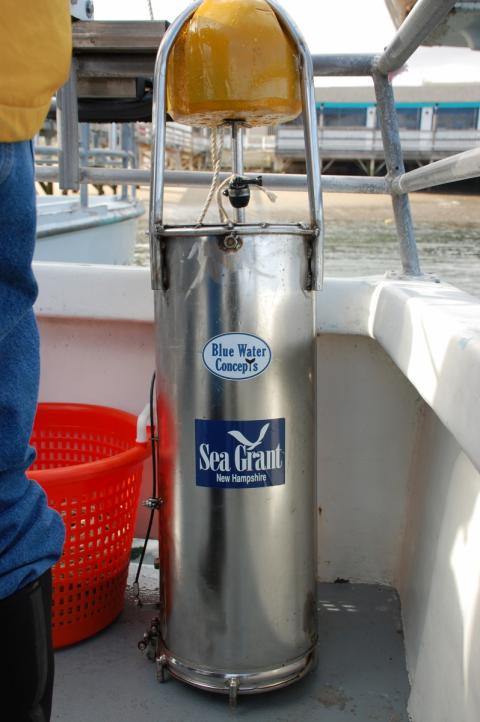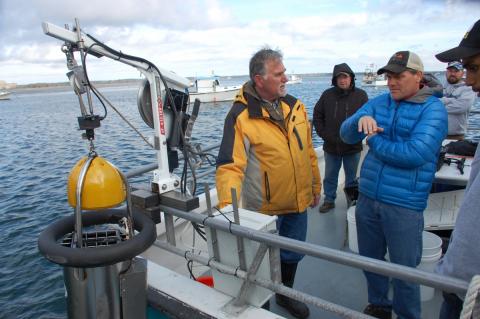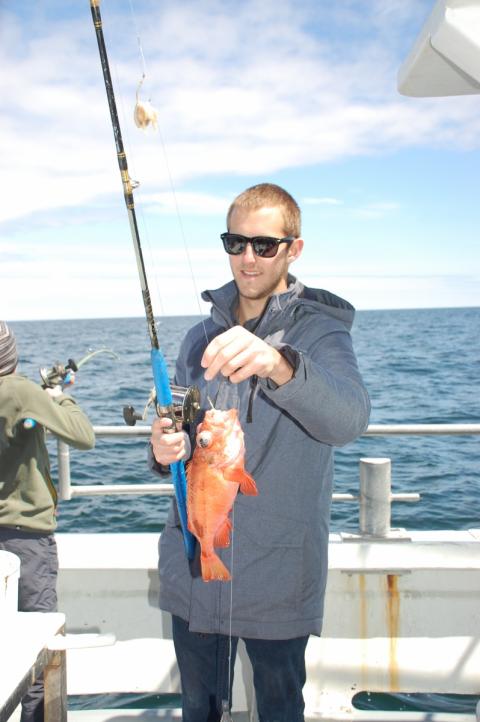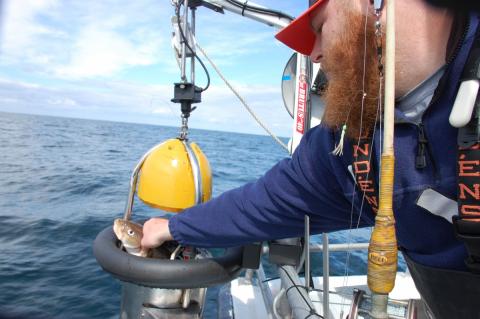A new device intended to improve the odds that a fish will live after catch and release is showing promise for use in deep sea fishing, thanks to a partnership among UNH researchers and students, a local business and a N.H. charter boat captain.
The device, dubbed the “BaroSafe System,” is a three-foot-tall cylindrical steel cage attached to a rope and pulley system that is stationed on the deck of a boat. The device will allow anglers to place half a dozen unwanted fish into the cage, lower them deep into the ocean and open the bottom trap door so the fish can swim out at their depth of capture. Early results indicate that the BaroSafe System helps prevent unnecessary fish mortality, which is important in the health of fish populations.
Fish that are brought up from the ocean may experience barotrauma — injury caused by the transition from deep, cold waters at higher pressure to shallow, warmer waters at lower pressure. Some fish species are able to tolerate barotrauma better than others; Gulf of Maine fish like cusk and redfish are particularly sensitive to barotrauma and often will not survive being brought to the surface and thrown back overboard. This is what fisheries managers refer to as “bycatch mortality.”
Rather than toss an unwanted fish overboard at the surface, scientists and engineers have been working on developing equipment that would bring the fish down to its depth of capture quickly in hopes of lessening the impacts of barotrauma. Alex Brickett, program manager at Blue Water Concepts in Eliot, worked on an early prototype of the BaroSafe System while he was a senior at UNH — he received an Undergraduate Research Award to develop equipment that would help lobstermen return undersized lobsters to depth quickly. This effort rolled into future discussions with UNH staff and local fishermen about how to apply the technology to fish bycatch.
With development funding provided by N.H. Sea Grant, Erik Chapman, fisheries specialist for NH Sea Grant/UNH Cooperative Extension, worked with Chris Glass, UNH research professor of zoology and ocean sciences, Mark Godfroy, a charter boat captain out of Seabrook, N.H., and the engineers at Blue Water Concepts to design a prototype based on Brickett’s undergraduate project. The team conducted a test-run of the BaroSafe System at sea with help from students in the UNH Fisheries and Aquaculture Club.
After catching fish using rod-and-reel on Godfroy’s boat, the team practiced using the device to return fish to various depths. A GoPro camera was attached to the side of the device to take underwater video footage of the process and determine the efficacy of the device. The UNH students recorded water temperature data and the fish species captured and the depth at which they were returned. Half a dozen redfish — the species most visibly experiencing barotrauma — were placed in the device and lowered to near the bottom of the ocean. Video footage revealed they swam out of the cage once the door was released, and those lowered the deepest did not pop back up on the water’s surface — a sign that indicated the redfish likely survived the catch-and-release experience.
How Can This Help Fish & Fishermen?
Gear induced discard mortality and survival is a key concern in fisheries because population models used in stock assessment are very sensitive to this parameter, and estimates of discard mortality are highly uncertain. In recreational fisheries, simple devices clipped to a drop line that quickly and safely return individual fish to capture depth have provided one tool that can help improve discard mortality. However, a critical barrier to broad adoption in recreational fisheries is that available systems do not return meaningful numbers of fish to capture depth quickly, making their use difficult in many typical fisheries operations. We are developing, building and testing a system that addresses these barriers through a partnership between engineers, recreational fishermen, University of New Hampshire (UNH) scientists and extension/outreach specialists. A prototype of such a system has been produced by our team through a small development grant from New Hampshire Sea Grant. This project underwent testing throughout the spring and summer of 2016.
Contact
Erik Chapman, Ph.D.
Director, NH Sea Grant
erik.chapman@unh.edu
(603) 862-1935




